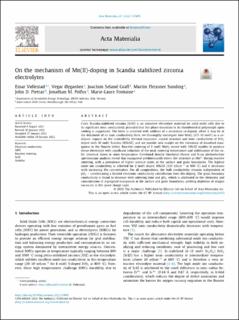| dc.contributor.author | Vøllestad, Einar | |
| dc.contributor.author | Øygarden, Vegar | |
| dc.contributor.author | Graff, Joachim Seland | |
| dc.contributor.author | Sunding, Martin Fleissner | |
| dc.contributor.author | Pietras, John D. | |
| dc.contributor.author | Polfus, Jonathan M. | |
| dc.contributor.author | Fontaine, Marie-Laure | |
| dc.date.accessioned | 2022-08-05T10:42:18Z | |
| dc.date.available | 2022-08-05T10:42:18Z | |
| dc.date.created | 2022-05-13T13:15:02Z | |
| dc.date.issued | 2022 | |
| dc.identifier.citation | Acta Materialia. 2022, 227 1-11. | en_US |
| dc.identifier.issn | 1359-6454 | |
| dc.identifier.uri | https://hdl.handle.net/11250/3010338 | |
| dc.description.abstract | Cubic Scandia-stabilized zirconia (ScSZ) is an attractive electrolyte material for solid oxide cells due to its significant ionic conductivity, provided that the phase transition to its rhombohedral polymorph upon cooling is suppressed. The latter is achieved with addition of a secondary co-dopant, albeit it may be at the detriment of its ionic conductivity Here, we thoroughly investigate how MnO2 (0.5–10 mol%) as a co-dopant impacts on the sinterability, thermal expansion, crystal structure and ionic conductivity of ZrO2 doped with 10 mol% Scandia (10ScSZ), and we provide new insight on the chemistry of dissolved manganese in the fluorite lattice. Reactive sintering of 2 mol% MnO2 mixed with 10ScSZ enables to produce dense electrolyte with significant reduction of the peak sintering temperature and stabilisation of the cubic structure down to room temperature. Combined density functional theory and X-ray photoelectron spectroscopy analyses reveal that manganese predominantly enters the structure as Mn2+ during reactive sintering, with a prevalence of higher valence states at the surface and grain boundaries. The highest oxide ion conductivity is achieved for 2 mol% doped 10ScSZ (120 mScm−1 at 800 °C) and it decreases with increasing Mn concentration. For all compositions, the bulk conductivity remains independent of pO2 – corroborating a limited electronic conductivity contribution from Mn-doping. The grain boundary conductivity is found to decrease with sintering time and pO2, which is attributed to the chemistry and concentration of segregated manganese at the surface and grain boundaries, yielding depletion of oxygen vacancies in the space charge layer. | en_US |
| dc.language.iso | eng | en_US |
| dc.publisher | Elsevier | en_US |
| dc.rights | Navngivelse 4.0 Internasjonal | * |
| dc.rights.uri | http://creativecommons.org/licenses/by/4.0/deed.no | * |
| dc.subject | Stability | en_US |
| dc.subject | ScSZ | en_US |
| dc.subject | Reactive sintering | en_US |
| dc.subject | SOFC | en_US |
| dc.subject | Electrical conductivity | en_US |
| dc.title | On the mechanism of Mn(II)-doping in Scandia stabilized zirconia electrolytes | en_US |
| dc.title.alternative | On the mechanism of Mn(II)-doping in Scandia stabilized zirconia electrolytes | en_US |
| dc.type | Peer reviewed | en_US |
| dc.type | Journal article | en_US |
| dc.description.version | publishedVersion | en_US |
| dc.rights.holder | © 2022 The Author(s). Published by Elsevier Ltd on behalf of Acta Materialia Inc | en_US |
| dc.source.pagenumber | 1-11 | en_US |
| dc.source.volume | 227 | en_US |
| dc.source.journal | Acta Materialia | en_US |
| dc.identifier.doi | 10.1016/j.actamat.2022.117695 | |
| dc.identifier.cristin | 2024374 | |
| dc.source.articlenumber | 117695 | en_US |
| cristin.ispublished | true | |
| cristin.fulltext | original | |
| cristin.qualitycode | 2 | |

